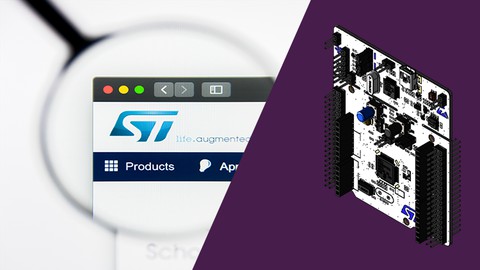
Embedded Systems STM32 HAL APIs Driver Development
Embedded Systems STM32 HAL APIs Driver Development, available at $74.99, has an average rating of 4.67, with 44 lectures, based on 248 reviews, and has 1948 subscribers.
You will learn about Write firmware using only HAL functions Understand the Cortex-M Architecture Write Analog-to-Digital Converter (ADC) drivers using HAL functions Write PWM drivers using HAL functions Write UART drivers using HAL functions Write TIMER drivers using HAL functions Write Interrupt drivers using HAL functions Write SPI drivers using HAL functions Write I2C drivers using HAL functions Write RTC drivers using HAL functions Write DMA drivers using HAL functions Write RCC drivers using HAL functions This course is ideal for individuals who are If you are an absolute beginner to embedded systems, then take this course. or If you are an experienced embedded developer and want to learn how to professionally develop embedded applications for ARM processors, then take this course. It is particularly useful for If you are an absolute beginner to embedded systems, then take this course. or If you are an experienced embedded developer and want to learn how to professionally develop embedded applications for ARM processors, then take this course.
Enroll now: Embedded Systems STM32 HAL APIs Driver Development
Summary
Title: Embedded Systems STM32 HAL APIs Driver Development
Price: $74.99
Average Rating: 4.67
Number of Lectures: 44
Number of Published Lectures: 44
Number of Curriculum Items: 44
Number of Published Curriculum Objects: 44
Original Price: $34.99
Quality Status: approved
Status: Live
What You Will Learn
- Write firmware using only HAL functions
- Understand the Cortex-M Architecture
- Write Analog-to-Digital Converter (ADC) drivers using HAL functions
- Write PWM drivers using HAL functions
- Write UART drivers using HAL functions
- Write TIMER drivers using HAL functions
- Write Interrupt drivers using HAL functions
- Write SPI drivers using HAL functions
- Write I2C drivers using HAL functions
- Write RTC drivers using HAL functions
- Write DMA drivers using HAL functions
- Write RCC drivers using HAL functions
Who Should Attend
- If you are an absolute beginner to embedded systems, then take this course.
- If you are an experienced embedded developer and want to learn how to professionally develop embedded applications for ARM processors, then take this course.
Target Audiences
- If you are an absolute beginner to embedded systems, then take this course.
- If you are an experienced embedded developer and want to learn how to professionally develop embedded applications for ARM processors, then take this course.
Welcome to the Embedded Systems STM32 Hardware Abstraction Layer (HAL) Driver Development course.
The STM32 Hardware Abstraction Layer (HAL) provides a simple, generic multi-instance set of APIs (application programming interfaces) to interact with the upper layers like the user application, libraries and stacks.
The HAL driver APIs are split into two categories: generic APIs, which provide common and generic functions for all the STM32 series and extension APIs, which include specific and customized functions for a given line or part number. The HAL drivers include a complete set of ready-to-use APIs that simplify the user application implementation. For example, the communication peripherals contain APIs to initialize and configure the peripheral, manage data transfers in polling mode, handle interrupts or DMA, and manage communication errors.
In summary, the HAL offers high-level and feature-oriented APIs with a high-portability level. These hide the MCU and peripheral complexity from the end-user.
With a programming based approach, this course is designed to give you a solid foundation in firmware and peripheral driver development for the STM32 family of microcontrollers. The goal of this course is to teach you how to navigate the microcontroller reference manual and datasheet to extract the right information to professionally build peripheral drivers and firmware using the STM32 HAL APIs
By the end of this course you will be able to develop drivers for peripherals like the ADC, UART,PWM, GPIO, TIMER,I2C, SPI, RTC, RCC, EXTI etc. You will also master the STM32 architecture and how to build professional embedded firmware for STM32 microcontrollers.
Please take a look at the full course curriculum.
REMEMBER : I have no doubt you will love this course. Also it comes with a FULL money back guarantee for 30 days! So put simply, you really have nothing to loose and everything to gain.
Sign up and let’s start toggling some register bits.
————————————–Some highlights————————————
Write Analog-to-Digital Converter (ADC) drivers using HAL functions
Write PWM drivers using HAL functions
Write UART drivers using HAL functions
Write TIMER drivers using HAL functions
Write Interrupt drivers using HAL functions
Write SPI drivers using HAL functions
Write I2C drivers using HAL functions
Write RTC drivers using HAL functions
Write DMA drivers using HAL functions
Write RCC drivers using HAL functions
Course Curriculum
Chapter 1: Introduction
Lecture 1: Downloading the required documentation
Chapter 2: Getting Started
Lecture 1: Notice
Lecture 2: Downloading CubeIDE
Lecture 3: Setting Up STM32CubeIDE
Lecture 4: Overview
Lecture 5: Notice
Lecture 6: Getting the right STM32 Package
Chapter 3: General Purpose Input/Output Driver Development
Lecture 1: Overview of ARM Cortex-M General Purpose Input/Output Module
Lecture 2: Notice
Lecture 3: Coding : Getting familiar with the Setup and HAL
Lecture 4: Coding : Developing a GPIO Driver using information from the documentations
Chapter 4: Universal Asynchronous-Synchronous Receiver-Transmitter (USART)
Lecture 1: Overview of the UART Protocol
Lecture 2: Coding : Developing a UART Driver (Pt. 1)
Lecture 3: Coding : Developing a UART Driver (Pt. 2)
Lecture 4: Coding : Retargeting printf
Chapter 5: General Purpose Timer Driver Development
Lecture 1: Understanding the System Tick (SysTick) Timer
Lecture 2: Understanding STM32 Timers
Lecture 3: Coding : Developing a Hardware Timer Driver (Pt. 1)
Lecture 4: Coding : Developing a Hardware Timer Driver (Pt. 2)
Chapter 6: Analog-to-Digital Converters Driver Development
Lecture 1: Understanding ADC Independents Modes
Lecture 2: Coding : Developing the ADC Continuous Conversion Driver (Part I)
Lecture 3: Coding : Developing the ADC Continuous Conversion Driver (Part II)
Lecture 4: Coding : Developing the ADC Single Conversion Driver
Chapter 7: Interrupt Programming
Lecture 1: Understanding Interrupts
Lecture 2: Coding : Developing the EXTI Input Interrupt Driver
Lecture 3: Coding : Using Multiple EXTI Input Interrupts
Lecture 4: Coding : Developing the ADC Interrupt Driver
Lecture 5: Coding : Developing the UART Interrupt Driver
Lecture 6: Coding : Using Multiple UART Modules
Chapter 8: Direct Memory Access (DMA) Driver Development
Lecture 1: Overview of the Direct Memory Access (DMA) Module
Lecture 2: Coding : Developing the ADC DMA Driver
Lecture 3: Coding : Developing the ADC Multi-Channel DMA Driver
Lecture 4: Coding : Developing the UART DMA Driver
Lecture 5: Coding : DMA Memory to Memory Transfer
Chapter 9: Serial Peripheral Interface (SPI) Driver Development
Lecture 1: Understanding the SPI Protocol
Lecture 2: Coding : Developing the SPI Polling Driver
Lecture 3: Coding : Developing the SPI Interrupt Driver
Lecture 4: Coding : Developing the SPI DMA Driver
Chapter 10: Inter- Integrated Circuit (I2C) Driver Development
Lecture 1: Understanding the I2C Protocol
Lecture 2: Coding : Writing an I2C Driver to read data from the ADXL345 Accelerometer (Pt1)
Lecture 3: Coding : Writing an I2C Driver to read data from the ADXL345 Accelerometer (Pt2)
Chapter 11: Real Time Clock (RTC) Programming
Lecture 1: Understanding Real Time Clocks
Lecture 2: Coding : Developing the Real Time Clock Driver
Chapter 12: Closing
Lecture 1: Closing Remarks
Instructors
-
BHM Engineering Academy
21st Century Engineering Academy -
Israel Gbati
Embedded Firmware Engineer
Rating Distribution
- 1 stars: 12 votes
- 2 stars: 10 votes
- 3 stars: 34 votes
- 4 stars: 72 votes
- 5 stars: 120 votes
Frequently Asked Questions
How long do I have access to the course materials?
You can view and review the lecture materials indefinitely, like an on-demand channel.
Can I take my courses with me wherever I go?
Definitely! If you have an internet connection, courses on Udemy are available on any device at any time. If you don’t have an internet connection, some instructors also let their students download course lectures. That’s up to the instructor though, so make sure you get on their good side!
You may also like
- Best Investing Courses to Learn in March 2025
- Best Personal Finance Courses to Learn in March 2025
- Best Health And Wellness Courses to Learn in March 2025
- Best Chatgpt And Ai Tools Courses to Learn in March 2025
- Best Virtual Reality Courses to Learn in March 2025
- Best Augmented Reality Courses to Learn in March 2025
- Best Blockchain Development Courses to Learn in March 2025
- Best Unity Game Development Courses to Learn in March 2025
- Best Artificial Intelligence Courses to Learn in March 2025
- Best Flutter Development Courses to Learn in March 2025
- Best Docker Kubernetes Courses to Learn in March 2025
- Best Business Analytics Courses to Learn in March 2025
- Best Excel Vba Courses to Learn in March 2025
- Best Devops Courses to Learn in March 2025
- Best Angular Courses to Learn in March 2025
- Best Node Js Development Courses to Learn in March 2025
- Best React Js Courses to Learn in March 2025
- Best Cyber Security Courses to Learn in March 2025
- Best Machine Learning Courses to Learn in March 2025
- Best Ethical Hacking Courses to Learn in March 2025























